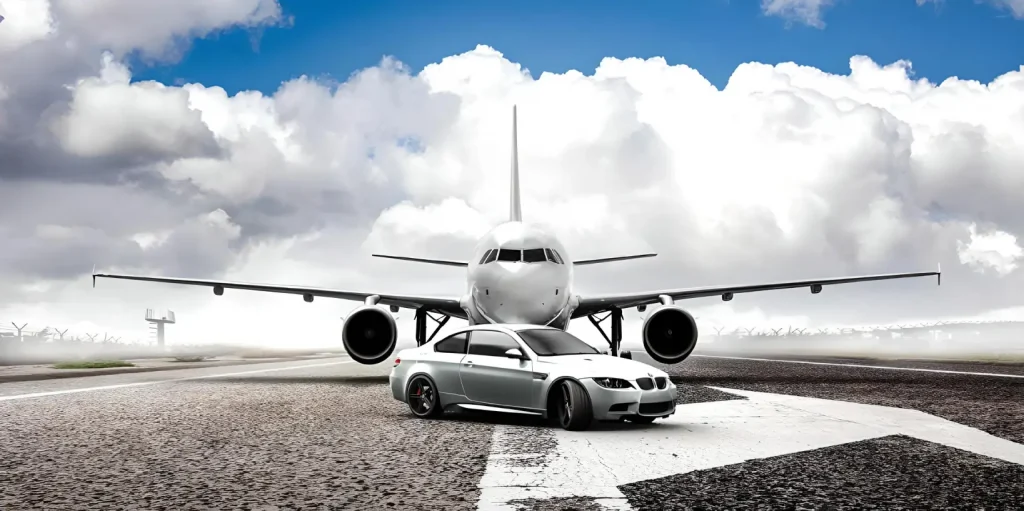
Planning a trip and wondering whether to fly or drive? You’re not alone. This age-old question plagues travelers seeking the most cost-effective and convenient way to reach their destination. While plane tickets and gas price often come to mind first, the answer isn’t always a simple one.
This comprehensive guide delves into the various factors influencing the total cost of flying versus driving, helping you determine the better option for your specific trip. We’ll explore:
Flying costs: Including plane tickets, checked bag fees, and potential airport parking expenses.
Driving costs: Considering gas prices, rental car fees, roadside assistance, and potential hotel rooms needs during long drives.
Additional factors: We’ll also touch on travel time, personal preferences, and environmental impact to provide a well-rounded analysis.
By comparing these factors and considering your travel dates, destination, travel party size, and personal preferences, you’ll be well-equipped to decide whether flying or driving makes more sense for your next adventure.
So, buckle up (or fasten your seatbelt) as we embark on this journey to uncover the truth: is it cheaper to fly or drive?
Fly vs. drive: The time factor
While cost often takes center stage in the “fly vs. drive” debate, time is another crucial factor influencing your decision. Understanding the time commitment associated with each option can significantly impact your travel experience and overall enjoyment.
Factors influencing the duration of each mode of transportation
Flying:
Generally faster: Especially for longer distances, airplanes offer a quicker way to reach your destination. Nonstop flights can significantly reduce travel time compared to driving, allowing you to spend more time exploring your final destination.
Airport logistics: Factor in additional time for security checks, boarding, and potential delays. While in the air, you might be limited in your productivity or entertainment options compared to driving.
Driving:
Flexible schedule: Road trips offer more control over your itinerary and allow for spontaneous stops along the way. You can avoid airport hassles and potentially reach your destination quicker for shorter distances (under 500 miles).
Time spent driving: Consider the total driving hours, including potential traffic delays and rest stops. Factor in additional time if you’re sharing driving duties with others.
Choosing the right option
Time-sensitive trips: If speed is a priority, flying might be the better option, especially for long distances.
Relaxing getaways: If you enjoy the journey and have ample time, a road trip can be a fun and scenic way to explore different locations.
Consider the trade-off: Weigh the time saved by flying against the potential drawbacks like airport logistics and limitations during the flight.
Additional factors
Number of travelers: For larger groups, driving might be more time-efficient if you factor in individual airport commutes and waiting times.
Personal preferences: Some travelers enjoy the comfort and convenience of flying, while others prefer the flexibility and control offered by road trips.
Ultimately, the best option depends on your individual priorities, travel style, and the specific details of your trip. By carefully considering the time factor alongside other aspects like cost and convenience, you can make an informed decision that aligns with your needs and preferences.
Fly vs. drive: The risk factor
While cost and time are crucial factors in choosing between flying and driving, risk also plays a significant role in the decision-making process. Here’s a breakdown of potential risks associated with each option:
Flying:
- Airplane accidents: While statistically rare, airplane accidents can have devastating consequences. However, advancements in aviation safety significantly reduce the likelihood of such incidents.
- Weather delays: Flights can be canceled or delayed due to bad weather, impacting your travel itinerary and potentially causing missed connections or additional expenses.
- Medical emergencies: Medical emergencies onboard can be stressful and require reliance on onboard medical personnel and resources.
Driving:
- Traffic accidents: Road accidents are a more frequent occurrence compared to airplane accidents, and the severity of consequences can vary depending on factors like speed, road conditions, and adherence to traffic rules.
- Vehicle breakdowns: Mechanical issues or breakdowns can significantly disrupt your trip, requiring repairs or roadside assistance, potentially leading to delays and additional costs.
- Theft or vandalism: Vehicles parked at airports or during road trips can be vulnerable to theft or vandalism, leading to financial losses and inconveniences.
Minimizing risks
- Research airlines and airports: Choose reputable airlines with a good safety record and consider the safety ratings of your chosen airports.
- Plan for contingencies: Factor in potential weather delays when booking flights and consider travel insurance to cover unexpected situations.
- Prioritize car maintenance: Ensure your vehicle is in good working condition before embarking on a road trip, and consider roadside assistance memberships for added peace of mind.
- Be aware of surroundings: Practice safe driving habits, stay alert on the road, and park your vehicle in well-lit and secure areas.
Choosing the right option
- Risk tolerance: Individuals with a higher risk tolerance might be more comfortable with driving, while those prioritizing safety might favor flying.
- Travel purpose: Business trips often require stricter adherence to schedules, making flying a potentially safer option due to its lesser susceptibility to delays compared to driving.
- Personal preferences: Some individuals feel more comfortable and in control behind the wheel, while others prefer the ease and perceived safety of air travel.
Ultimately, the best option depends on your individual risk tolerance, trip purpose, and personal preferences. By carefully considering these factors alongside cost, time, and other relevant aspects, you can make an informed decision that aligns with your priorities and ensures a safe and enjoyable travel experience.
Fly vs. drive: The financial aspect
When deciding between flying and driving, cost often takes center stage. While the initial allure of road trips might lie in their perceived affordability, a comprehensive financial analysis is crucial for making an informed decision. Here’s a breakdown of the key cost factors to consider:
Flying:
- Plane tickets: The primary expense, with prices fluctuating based on travel dates, airlines, routes, and booking time. Consider round-trip fares and potential baggage fees.
- Airport transportation: Factor in parking costs if using your own car, or rideshare/shuttle fees if relying on alternative transportation to the airport.
Driving:
- Gas: Prices can vary significantly depending on vehicle fuel efficiency, chosen route, and gas station locations. Use online tools like Google Maps to estimate fuel costs based on your desired route.
- Vehicle maintenance: Consider potential car maintenance needs before and during the trip, especially for longer distances.
- Tolls: Factor in potential toll road fees along your chosen route.
- Accommodation: For longer road trips, you might need to factor in hotel room expenses for overnight stays.
Additional considerations
- Rental cars: If flying and needing a car at your destination, consider rental car costs, including insurance and potential one-way drop-off fees.
- Travel party: For multiple people, compare the cost of multiple plane tickets versus fuel, car rental, and potential hotel stays associated with driving.
- Personal preferences: Factor in the value you place on convenience, time saved, and comfort when comparing the overall financial picture.
Making an informed decision
- Compare costs: Utilize online tools and travel websites to compare flight prices, rental car options, and estimated gas costs for your specific route and travel dates.
- Consider hidden costs: Don’t overlook parking fees, airport transportation, potential roadside assistance, and meal expenses during road trips.
- Evaluate your priorities: Weigh the financial implications against the time factor, flexibility, and personal preferences associated with each option.
Remember, the “cheaper” option isn’t always the most suitable choice. By carefully comparing costs, accounting for hidden expenses, and prioritizing your needs, you can make a financially sound decision that aligns with your overall travel goals.
Drive vs. fly: The sanitation aspect
While cost, time, and convenience often dominate discussions about flying versus driving, sanitation also emerges as a relevant factor, particularly in the age of heightened hygiene awareness. Let’s explore the sanitation considerations associated with each travel option:
Flying:
- Airplanes: Cabin air is typically filtered and recirculated, potentially raising concerns about exposure to airborne germs and contaminants, especially on crowded flights.
- High-touch surfaces: Frequent contact with surfaces like tray tables, armrests, and lavatory fixtures necessitates diligent hand hygiene practices.
- Limited control: Passengers rely on airline cleaning protocols and individual passenger behavior for maintaining cabin sanitation.
Driving:
- Personal vehicle: Offers greater control over the cleaning and sanitization practices employed within your own car.
- Flexibility: Allows for frequent stops for handwashing and sanitizing, especially during road trips with multiple passengers.
- Potential risks: Rest areas and gas stations can introduce new touchpoints and potential hygiene concerns.
Additional factors
- Travel party size: The risk of exposure to germs generally increases with the number of individuals sharing a confined space, regardless of the chosen mode of transportation.
- Personal preferences: Some individuals might feel more comfortable in the controlled environment of their own car, while others might prioritize the perceived efficiency of air travel.
- Destination hygiene practices: Research hygiene practices and potential health risks at your final destination to make an informed decision.
Making an informed decision
- Prioritize hygiene: If hygiene is a top concern, consider increased handwashing, sanitizing wipes, and personal protective equipment during both flying and driving.
- Evaluate individual needs: Individuals with compromised immune systems or heightened hygiene concerns might favor the controllable environment of their own car.
- Research airline practices: Choose airlines known for stringent cleaning protocols and air filtration systems.
Ultimately, the “sanitary” option depends on individual priorities, risk tolerance, and the specific circumstances of your trip. By considering all relevant factors and taking appropriate precautions, you can ensure a safe and enjoyable travel experience regardless of whether you choose to fly or drive.
Flying vs. driving: The Enjoyment Aspect
Beyond the practical considerations of cost, time, and sanitation, the enjoyment factor plays a crucial role in shaping your travel experience. Whether you find flying or driving more enjoyable depends largely on your personal preferences and travel style.
Flying:
- Convenience: Offers a faster and more relaxed way to reach your destination, minimizing travel time and allowing you to arrive feeling refreshed.
- Scenic views: Window seats on nonstop flights can provide breathtaking aerial views, adding a unique element to your journey.
- Limited distractions: Airplane cabins offer a controlled environment with minimal distractions, allowing you to catch up on work, read, or simply relax.
Driving:
- Flexibility and control: Road trips offer greater freedom and spontaneity, allowing you to set your own pace, choose your route, and explore interesting stops along the way.
- Scenic journey: Experience the changing landscapes and discover hidden gems along the way, creating lasting memories.
- Sense of adventure: Embark on a personal journey behind the wheel, fostering a sense of accomplishment and independence.
Additional factors
- Travel companions: Sharing the driving duties and enjoying conversations with friends or family can make road trips more enjoyable.
- Personal preferences: Some individuals find flying stressful or confining, while others dislike the long hours spent behind the wheel.
- Destination type: Road trips might be particularly enjoyable for exploring scenic regions or visiting multiple locations along the way.
Making an informed decision
- Consider your personality: Are you someone who thrives on spontaneity and enjoys the journey itself, or do you prefer a faster and more predictable travel experience?
- Evaluate your travel companions: If traveling with others, consider their preferences and how each option might impact their enjoyment.
- Plan your itinerary: If driving, factor in interesting stops and consider the overall route to maximize the enjoyment of the journey.
Ultimately, the “most enjoyable” option is subjective and depends on your individual priorities and travel style. By carefully considering these factors, you can choose the transportation mode that best aligns with your desire for a memorable and enjoyable travel experience.
Driving vs flying: The Environmental Impact
In today’s world, environmental consciousness plays a significant role in travel decisions. Understanding the environmental impact of both flying and driving is crucial for making informed choices that align with your sustainability goals.
Flying:
- Greenhouse gas emissions: Airplanes emit significant amounts of carbon dioxide (CO2) and other greenhouse gases, contributing to climate change. The impact is particularly pronounced for short-haul flights due to the higher emissions during takeoff and landing.
- Noise pollution: Aircraft noise can disrupt wildlife and communities near airports, impacting local environments.
Driving:
- Vehicle emissions: Cars and other vehicles also emit greenhouse gases, primarily CO2, but the overall impact per passenger is generally lower than flying for short to medium distances.
- Fuel type: Choosing fuel-efficient vehicles and alternative fuels like hybrids or electric cars can significantly reduce your environmental footprint.
Additional factors
- Number of passengers: The environmental impact per person decreases for both flying and driving as the number of passengers sharing the journey increases.
- Trip distance: For longer distances, flying might become more efficient per passenger due to economies of scale, while driving remains less impactful for shorter trips.
- Offsetting options: Consider carbon offset programs to mitigate the environmental impact of your travel, regardless of the chosen mode of transportation.
Making an informed decision
- Evaluate the distance: For shorter trips, driving might be the more environmentally friendly option.
- Consider carpooling: Sharing the ride with others significantly reduces the environmental impact per passenger for both driving and flying.
- Explore alternative travel options: If feasible, consider trains, buses, or other forms of public transportation with potentially lower environmental footprints.
Ultimately, the “environmentally friendly” option depends on various factors specific to your trip. By carefully considering the distance, travel party size, vehicle type, and available alternatives, you can make a conscious choice that minimizes your environmental impact and contributes to a more sustainable future.
Conclusion
When weighing the cost-effectiveness of flying vs driving, it’s essential to factor in travel insurance. Whether you choose to fly or drive, unforeseen events can occur during your trip, such as illnesses, injuries or unexpected emergencies. Having travel insurance safeguards your finances and provides assistance during unexpected situations, offering a safety net regardless of the mode of transportation you select. It ensures you’re covered financially and supported throughout your journey, allowing you to navigate any unexpected events with peace of mind.






